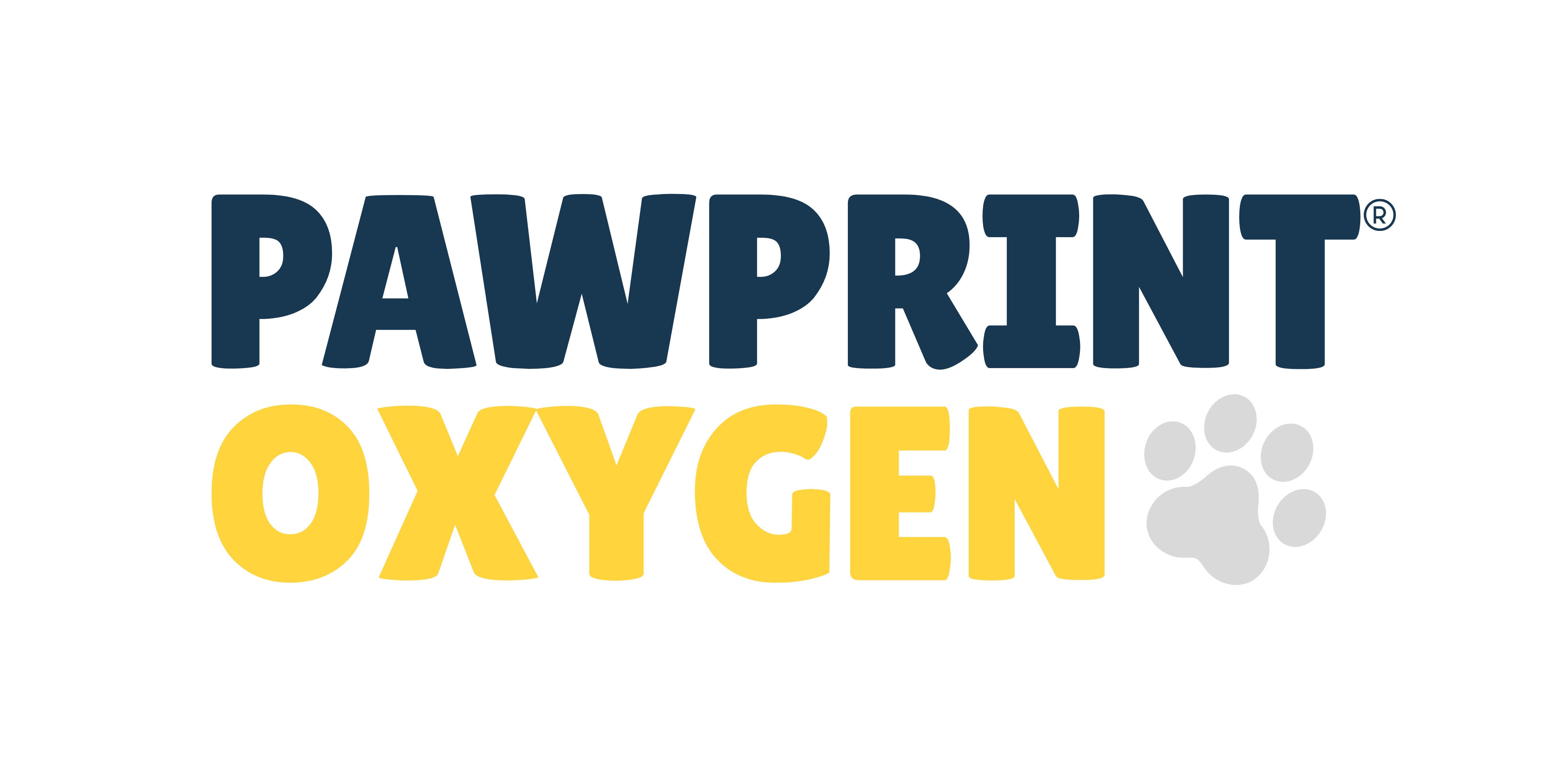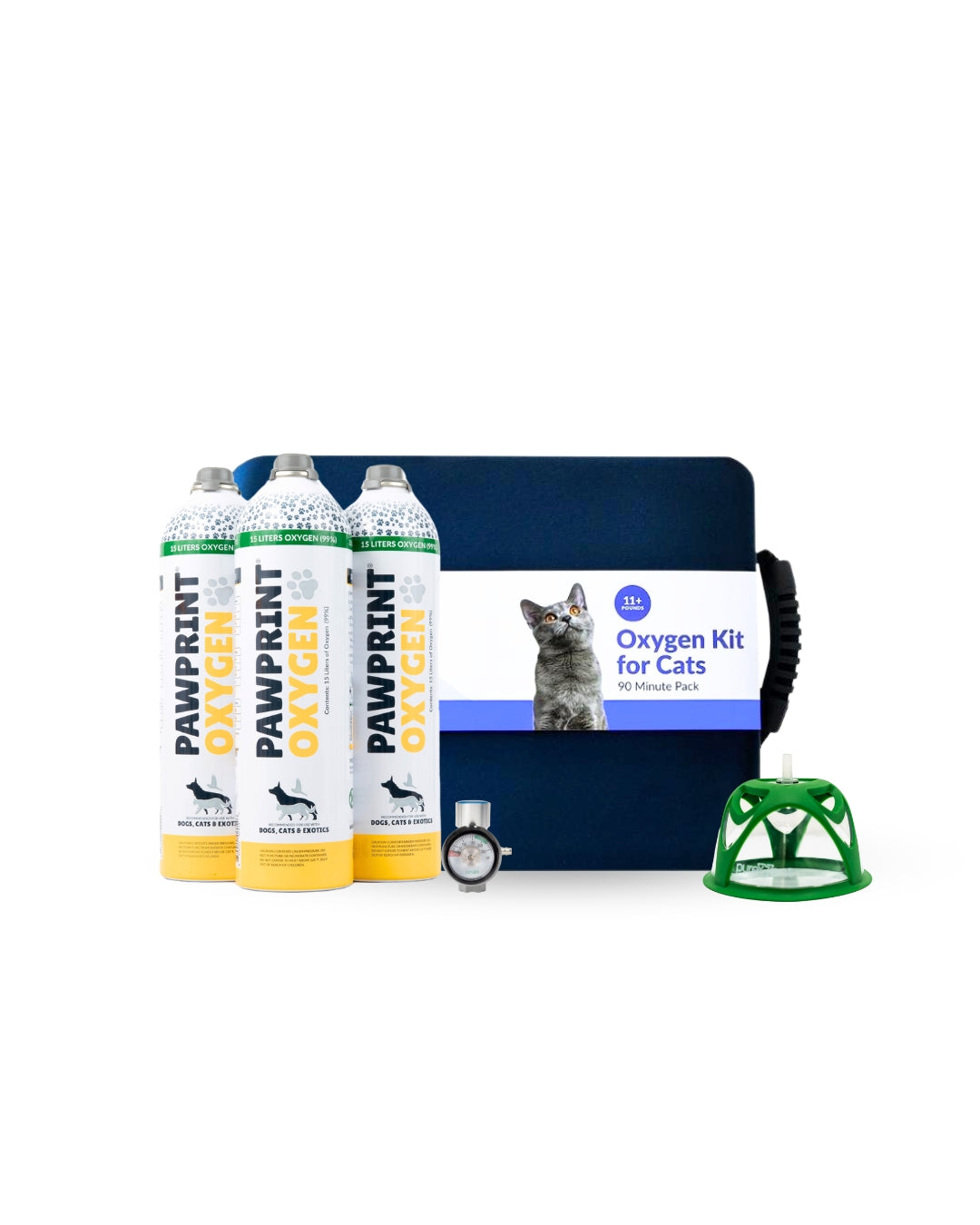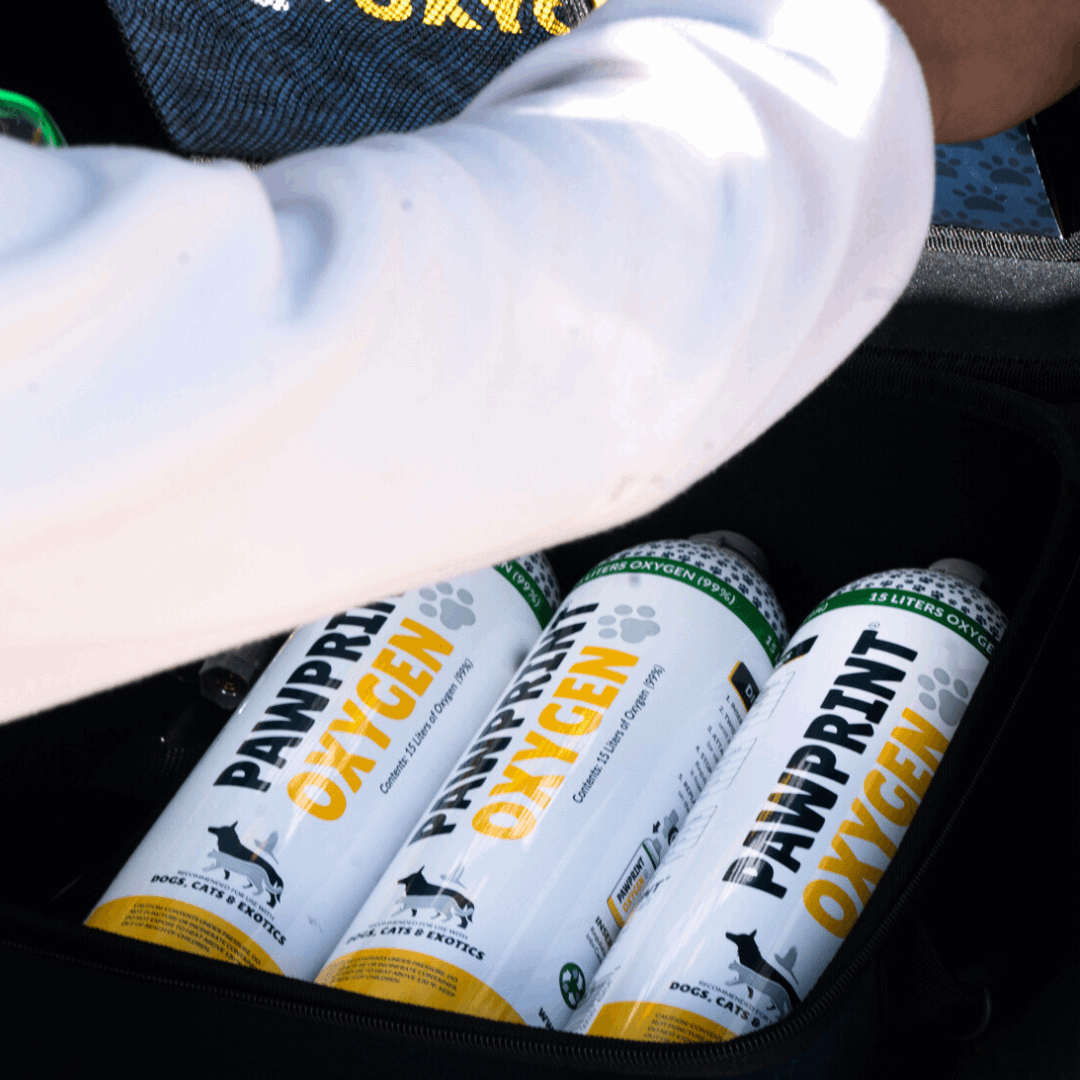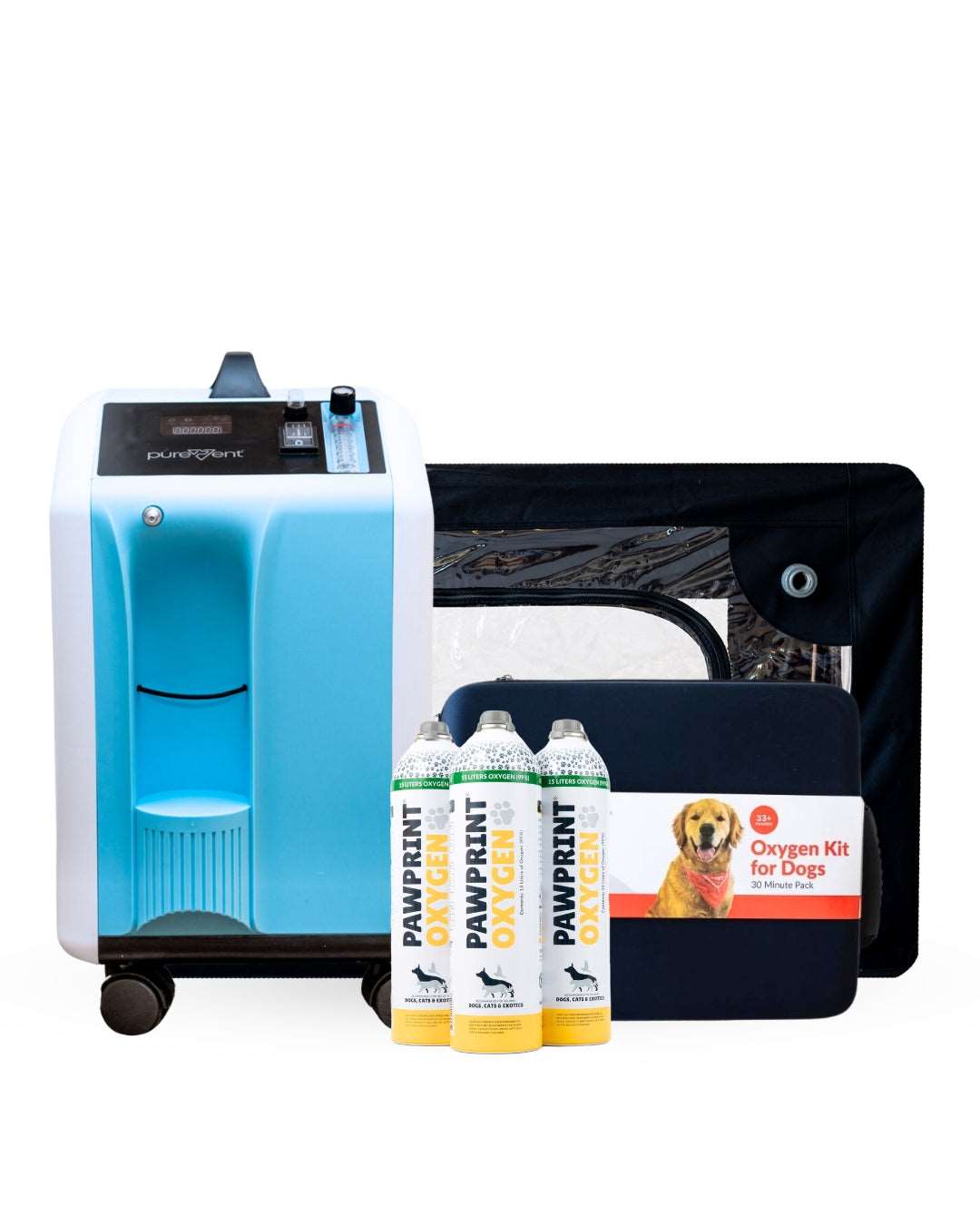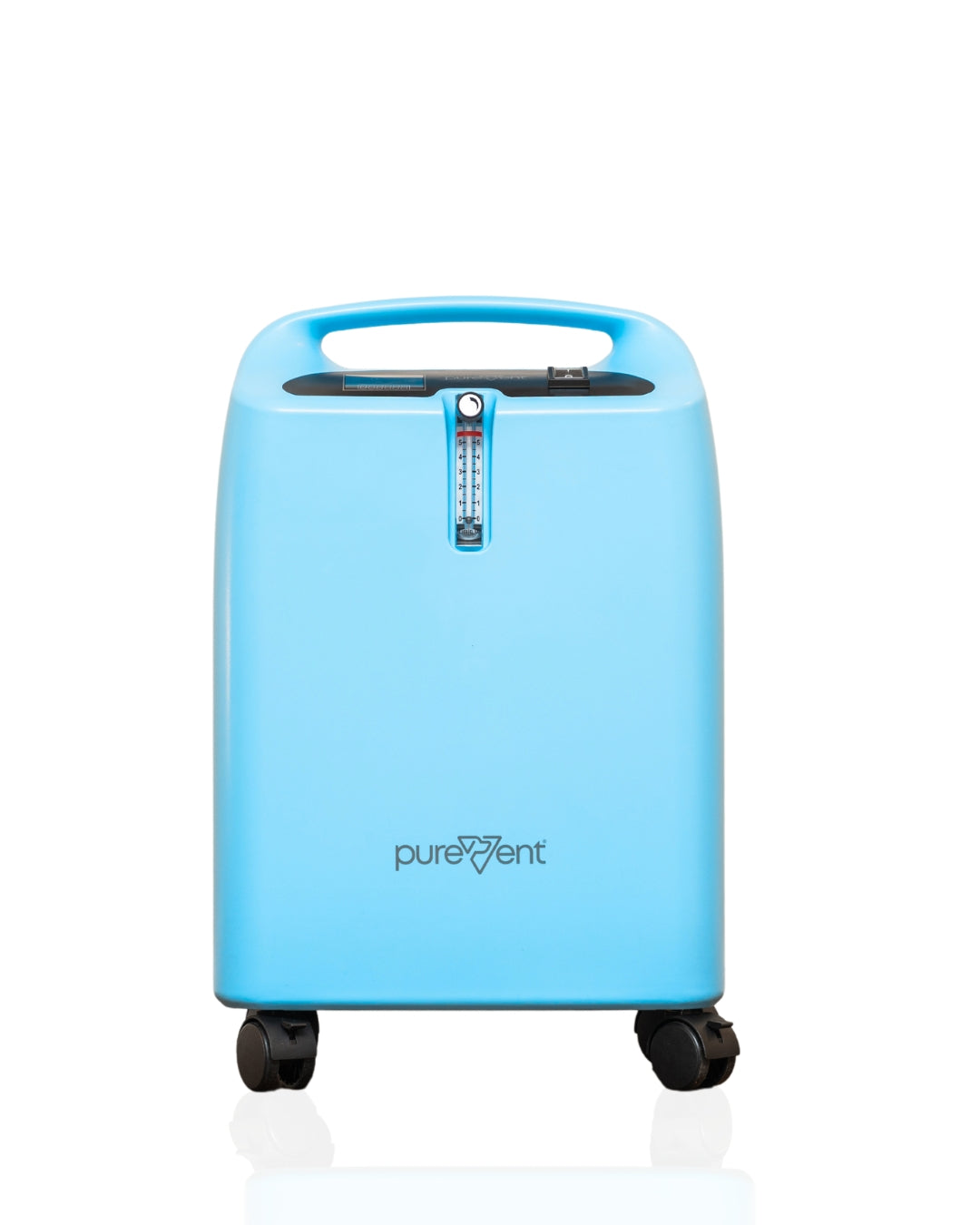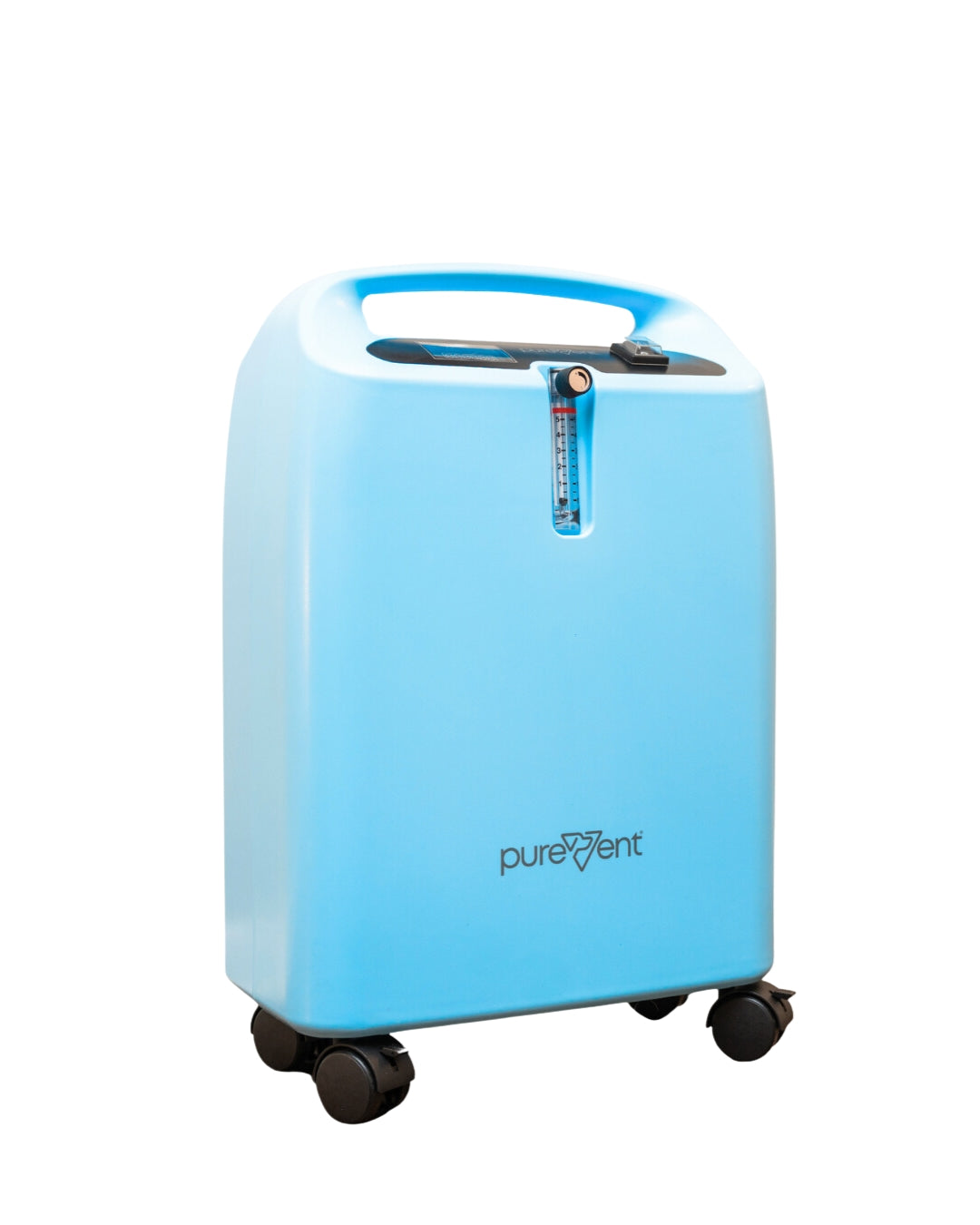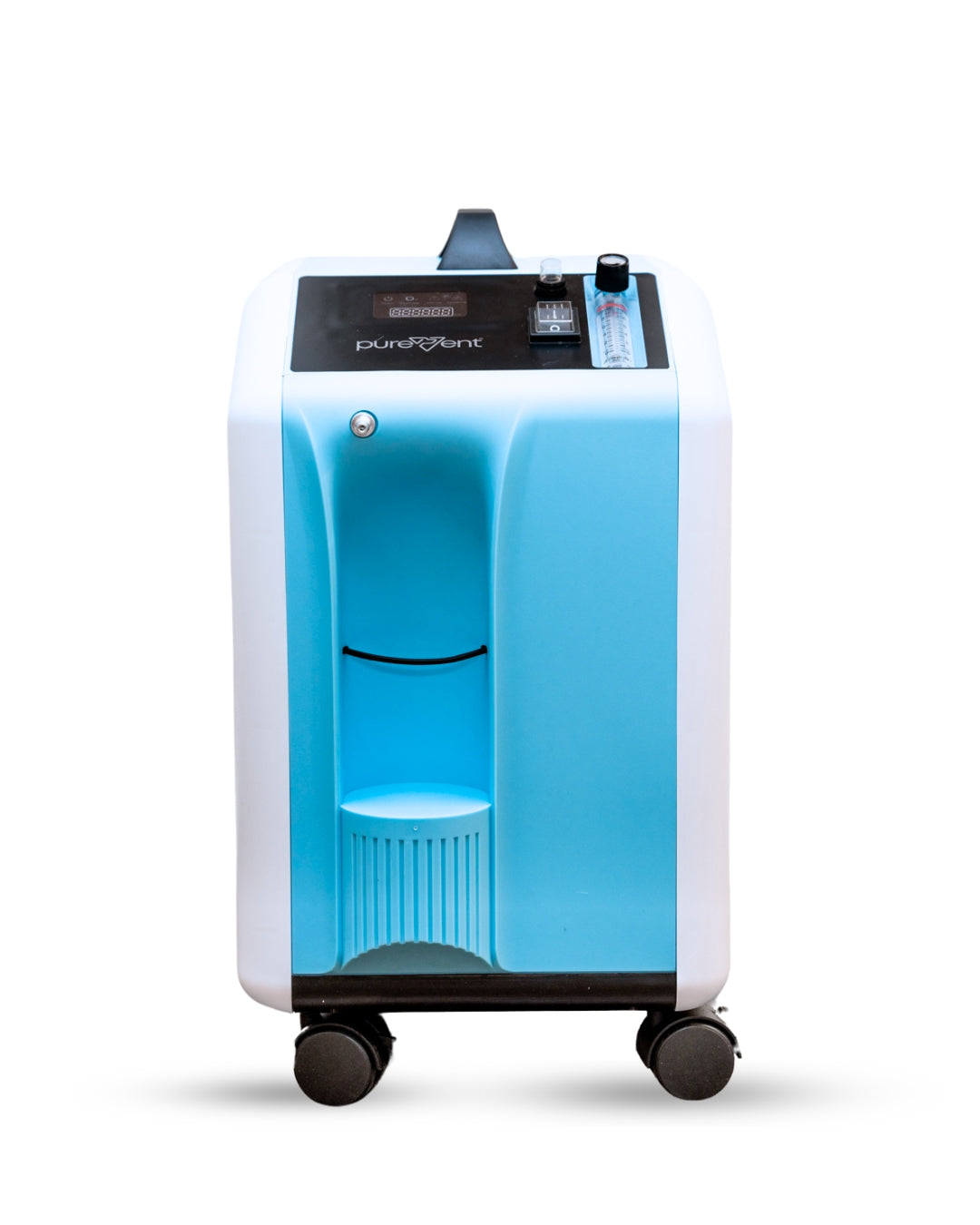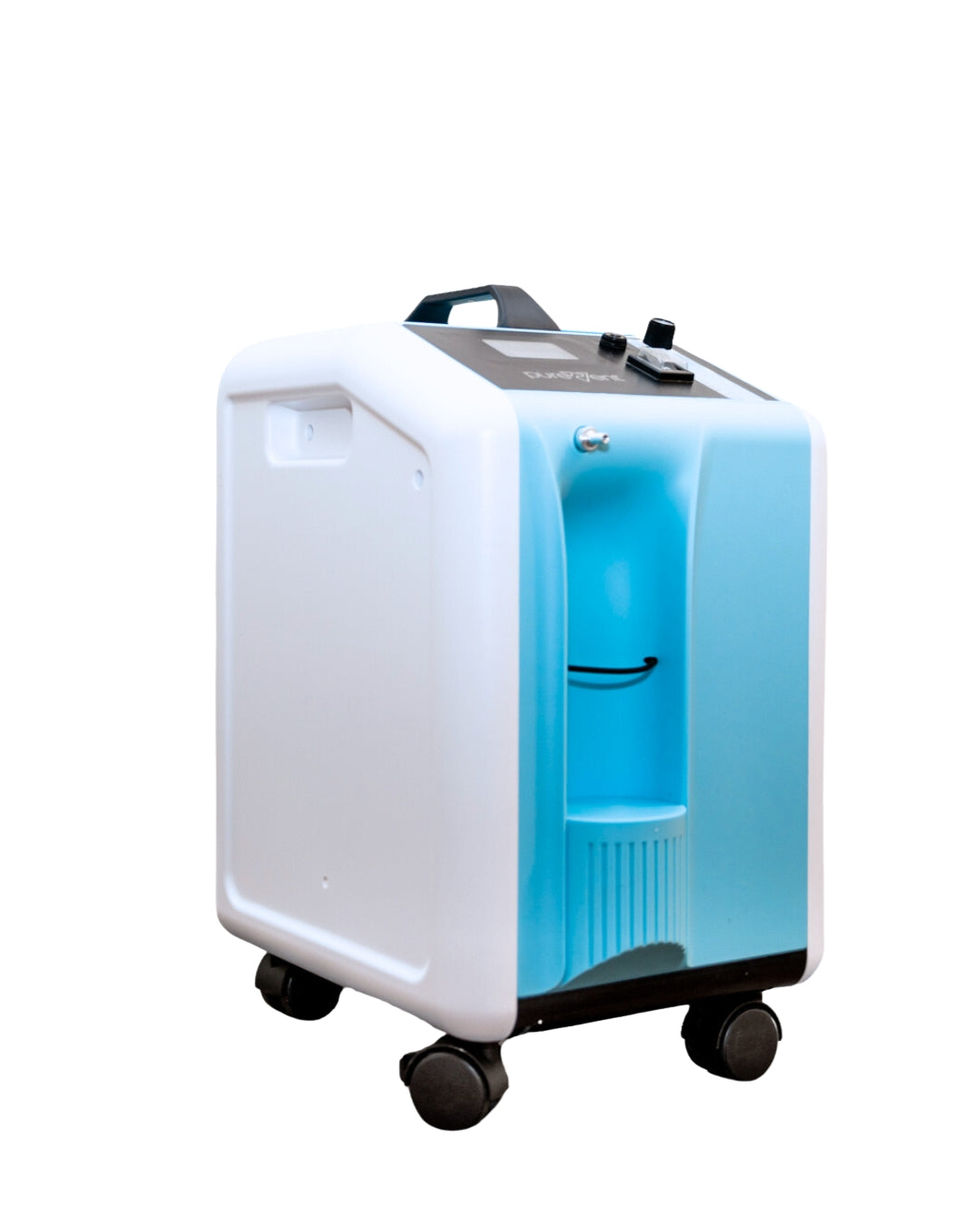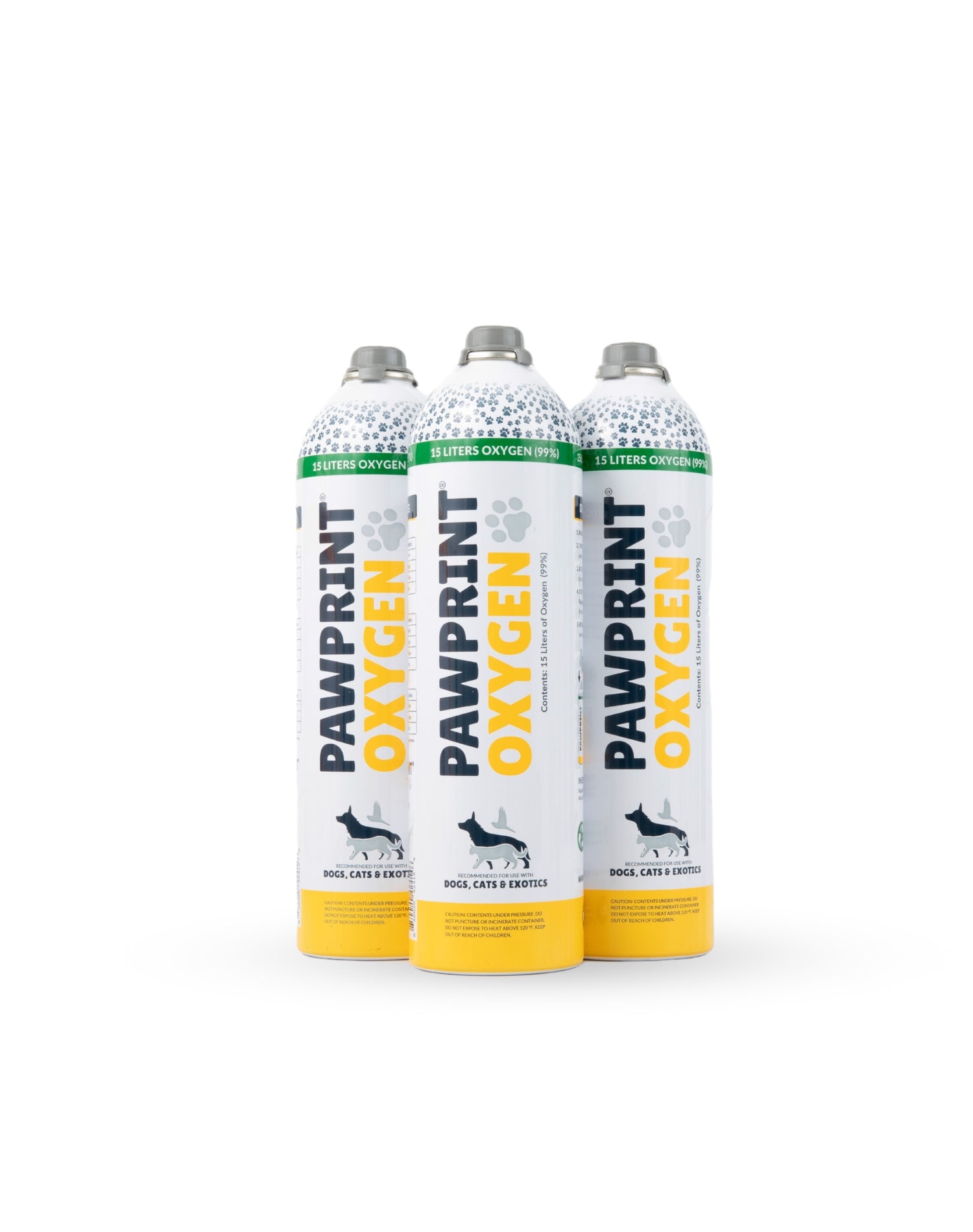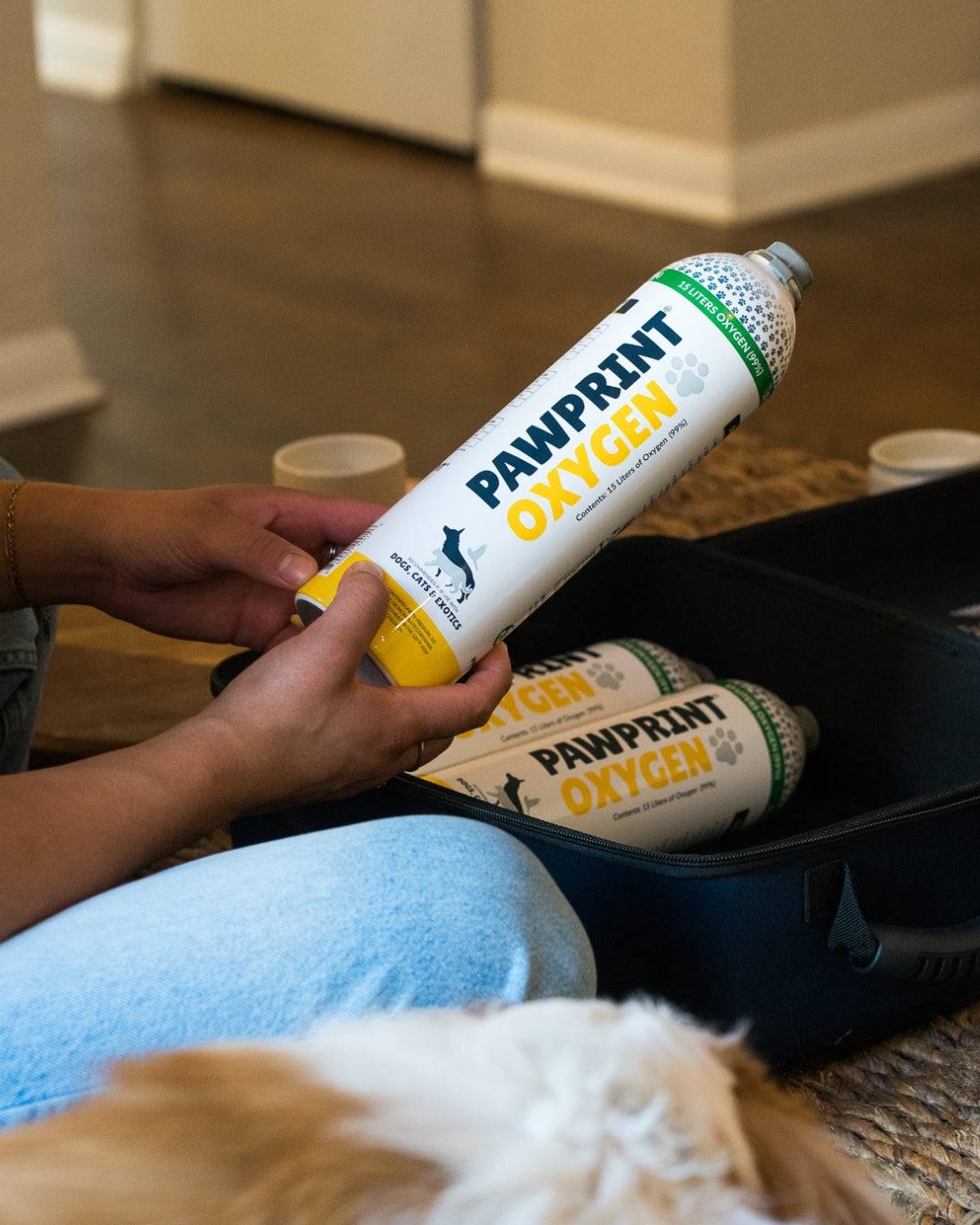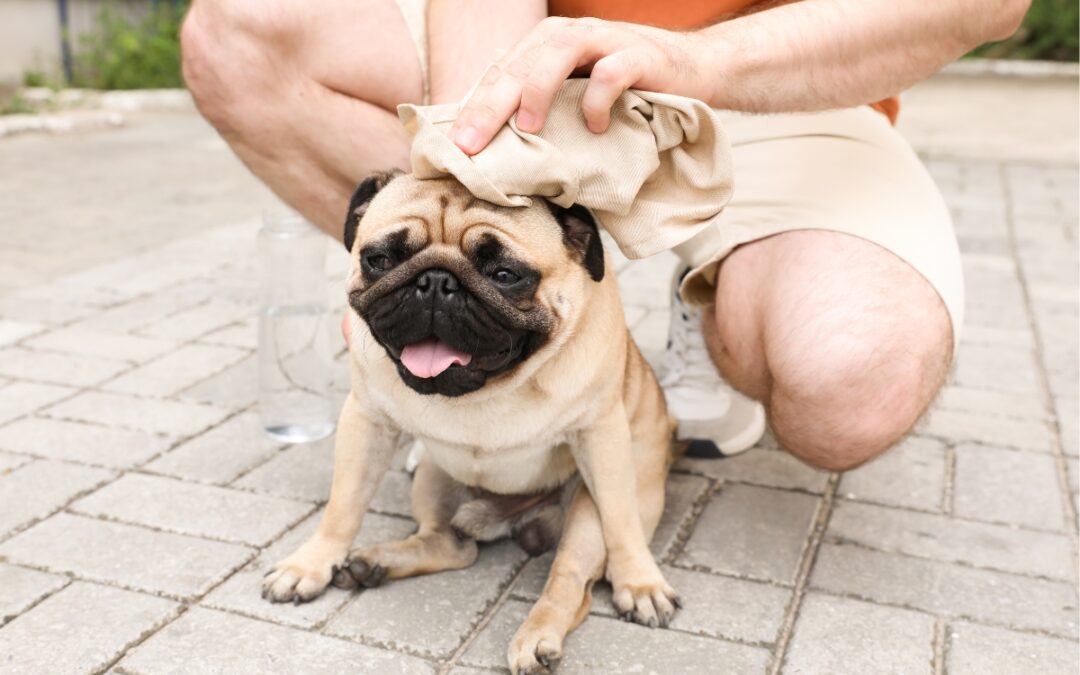Purchasing oxygen therapy equipment can seem daunting when pet owners find out they need it for their pet. In years past, giving oxygen therapy meant purchasing or renting a heavy tank that was not only unwieldy, but needed to be refilled and could not be safely used in the car. Thankfully, Pawprint Oxygen’s Portable Oxygen Kits introduced to pet owners the ability to provide therapy on-the-go with small handheld canisters. The portable kits contain everything you need to administer oxygen: canisters, tubing, a regulator, and a PureVent Pet Oxygen Mask.
The canisters are lightly pressurized, like a can of hairspray, so they are safe to use in the car. Weighing less than a quarter of a pound each, the canisters can be easily used during transport to a vet appointment or to the pet ER, on a walk, or around the house, for oxygen therapy whenever and wherever it’s needed.
What Are Pawprint Canisters and How Do I Use Them?
Purchasing the correct kit for your pet is important, as flow rate, duration, and usage of the canisters need to match your pet’s needs to be effective. Flow rate is a term used to refer to the dosage of oxygen being given. The canisters use a device called a regulator to release the oxygen at a specific flow rate, and the flow rate is selected based on your pet’s species and weight.
The regulator that will come in your Portable Kit is based on your pet’s weight and species and can be easily selected by purchasing a pre-made oxygen kit. For example, for a dog weighing 15lb, you will want to purchase the Portable Oxygen Kit for Dogs 11-22lbs. This kit will come with a 1.0 Liter Per Minute (LPM) flow rate regulator, which will ensure that the pet gets an adequate amount of oxygen for their weight.
Portable, Low-Pressure 15L Oxygen Canisters
Our oxygen canisters are lightweight, low-pressure, and safe to use in transport for your pet. Each canister holds 15L of pure oxygen and rescue oxygen kits come with either 3 or 6 canisters (depending on your pet's weight)!
Understanding Your Oxygen Canister Duration
The portable canisters in your kit will each contain 15 Liters of oxygen and will last a specific duration depending on the flow rate regulator used. Please refer to the below chart for the duration of the canisters for each flow rate:
- 0.5 LPM at 30 minutes per canister
- 1.0 LPM at 15 minutes per canister
- 2.0 LPM at 7.5 minutes per canister
- 3.0 LPM at 5 minutes per canister
The pre-made kits will take the guesswork out of selecting the flow rate needed, as each pertains to a specific weight class of pet.
For example, a cat weighing 9lb, the owner will want to purchase the Oxygen Kit for Cats 0-11lbs, which will come with a 0.5LPM regulator. There are three canisters in the kit, and each canister in the kit will last 30 minutes, giving you a total of 90 minutes of portable oxygen.

How To Use Your Oxygen Canisters
Administering oxygen therapy with portable oxygen canisters is easy. The step-by-step instructions that come with your oxygen kit are also accompanied by an email which provides links to some helpful videos you can watch. Here is a step-by-step guide to using the canisters:
-
Connect one end of the oxygen tubing to the end of the PureVent pet oxygen mask.
-
Connect the other end of the tubing to the metal barb on the regulator. Both ends of the oxygen tubing are the same, so it does not matter which end you select.
-
Place the regulator on the top of the canister. Gently push down, and twist clockwise until the regulator ‘clicks’ into place. The oxygen will now be flowing.
-
You will notice that once the regulator is inserted into the canister, the pressure gauge will now read how full the canister is. Keep this in mind as you administer oxygen to your pet, so you know when to switch out to a new canister when necessary.
-
Slowly place the mask over your pet’s snout and administer oxygen until they are breathing comfortably. For a less severe respiratory episode, typically a session of about 3-5 minutes is long enough to make them comfortable. In the case of a severe episode, provide oxygen as you plan to transport your pet to the ER, and keep the oxygen flowing during transport.
- To stop the flow of oxygen, twist the regulator counterclockwise and pull the regulator straight up and off the canister. If the canister is not yet empty, the rest of the oxygen will stay under pressure inside the canister until the next time you need it. If empty, you can dispose of the canister in your recycling bin or in the trash.
Administering Therapy To Your Pet With Pawprint Canisters
The oxygen canisters can be used to provide treatment in the case of respiratory distress.
Here are some signs that your pet may be in distress:
- Heavy panting that does not resolve with rest
- Open-mouthed breathing (cats)
- Blue tinged gums or tongue
- Exercise intolerance
- Listlessness or lethargy
- Wheezing, retching, or vomiting
- Collapse
When you notice your pet is experiencing a respiratory distress episode, you will want to start providing oxygen right away. The earlier you can treat the pet, the better the outcome. Some conditions may also have specific triggers that can cause the pet to go into a respiratory episode, like stress from a visitor, barking at the mailman, or playing outside when it’s warm out. If you recognize a trigger, providing oxygen before the episode even begins can also be very beneficial and may even stop the pet from having a respiratory distress episode.
Duration of treatments will vary from pet to pet with different conditions but typically, you can start to administer treatments anywhere from 3-8 minutes at a time or until you see signs of your pet getting respiratory relief. In transport, pets can be administered the length of your trip.

Getting Your Pet Used to the PureVent Pet Oxygen Mask
Each Portable Kit will come with a PureVent Pet Oxygen Mask. Available in three sizes, the kit will include the mask size that best fits your pet, based on their species and weight class. When treatment is needed, you will hold the mask up to their muzzle, and start the flow of oxygen. The mask’s patented design ensures that your pet is getting the highest percentage of oxygen possible. The PureVent Mask allows oxygen to saturate up to 62%, making it ideal for use in emergency situations where high concentrations of oxygen are needed.
Many pet owners are afraid their pets will not adjust well to the mask. Here at Pawprint, we have worked with thousands of pets, and we have some helpful tips to get your pet to happily accept treatment:
- For food-motivated pets, put a small amount of a treat inside the mask. For example, a tiny smear of peanut butter for dogs or a Churu squeezable treat for cats. (Don’t worry about the mess! Our masks can be cleaned with a mild soap and water when needed).
- Set the mask next to the pet while they are eating. Getting them used to the sight of the mask while they are experiencing something positive (like their dinner) lends them to be more accepting of the mask when treatment is needed.
- Put the mask over your own face while you’re hanging out with your furry loved one. No need to turn on the oxygen. Just by holding the mask up to your face while they are watching can teach them that the mask is harmless.
- Go slow and never force the mask over their muzzle. When treatment begins, we recommend holding the mask six inches out from the end of their nose, and slowly bringing it towards them little by little, which gives them time to adjust to the mask and the flow of oxygen.
- When deciding on a course of treatment, pet owners must consider their pet’s temperament, along with their health needs. If your pet is completely against the mask and using it is causing more harm than good, simply remove the mask from the end of the tubing and hold the tubing up to their mouth and nose. Your pet will at least receive some treatment, and in the case of an emergency, some is always better than none.
Maintenance and Storage Of Your Oxygen Canisters
The Pawprint Canisters require little to no maintenance. To keep the canisters in working order, we recommend keeping them away from open flames. Treat the canisters like an aerosol can, and do not allow them to sit at temperatures above 120 degrees Fahrenheit, and do not pierce the canisters. Once the canisters are empty, you can dispose of them in your recycling bin or in the trash if your area doesn’t have recycling.
The regulator, tubing, and pet oxygen mask are all reusable. If needed, the mask can be cleaned with a mild soap and water. Allow the mask to dry before using to avoid irritation to your pet’s skin.
Recognizing When to Replace Your Canisters
When you are administering oxygen with the Pawprint Canisters, it is important to understand how to tell when a canister is almost empty. Since oxygen is invisible and the flow rates administered to pets are low and very hard to hear, it can be hard to tell when the oxygen is still flowing. Thankfully, the regulator has a pressure gauge that will show you exactly how much oxygen you have left!
When you place the regulator onto a canister and twist to start the flow of oxygen, the regulator will be reading how much pressure the canister contains. When the canister is full, the pressure will be high, and the gauge will show that the can is full. When the pressure lowers, the needle on the gauge will register this and show you how much oxygen you have left. When the needle reaches the red section on the canister, your can is now empty and can be disposed of.
Keeping an eye on the clock can also help knowing when to switch out the canisters. Since the canisters have a fixed flow rate, each canister will last a specific duration. Once the canister is empty, it is very easy to switch to a new one if continued oxygen therapy is needed. You will twist the regulator counterclockwise off the empty canister, and then place the regulator onto the new canister and twist clockwise to start the flow of oxygen.
Emergency Situations and Backup Plans
It is always best to plan for the worst and hope for the best. This is especially true with your family’s medical needs, including your furry family members. Emergencies can arise anywhere and at any time, so having a plan can take some of the stress out of a difficult situation. For pets that require oxygen therapy, having extra canisters on hand is a good way to ensure your pet will have ample oxygen whenever they need it. We recommend having enough oxygen on hand to get you to and from the nearest pet ER, in case transport is needed.
Here are some more tips to planning for pet emergencies:
- Keep the address and phone number to your nearest pet ER in your cell phone or handy on a piece of paper.
- Have a few days’ worth of extra medication available in case you can’t go to the pharmacy or veterinary office right away.
- Keep a pet first aid kit on hand. Include items like pet safe wound wrap or spray, styptic power, gauze, a thermometer, an extra leash and/or a muzzle, Benadryl (if approved by your veterinarian), and gloves.
- Know where your pet carrier and leash are and make sure you have quick access to them.
With the introduction of the Portable Kits, oxygen therapy for pets is now more accessible than ever before. With a simple design and clear, concise instructions, the Pawprint Canisters are a great product to have on hand for emergencies, whether they arise in your home or on-the-go.
Make sure to set up and test your oxygen kit before needing it. That way you'll know how to use it when the time comes.
Read the flow rate regulator to see how much oxygen is in your canister.
Treat train your pet with the Pet Oxygen Mask so that they are used to it, if and when they ever need it.
